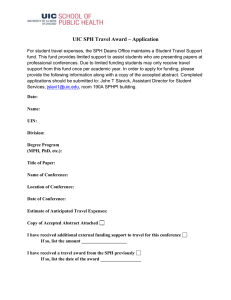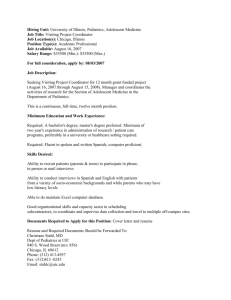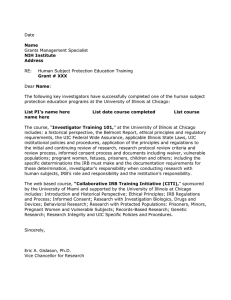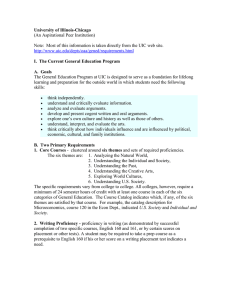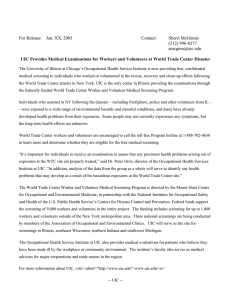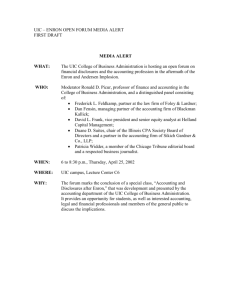Facilities and Other Resources THE UNIVERSITY OF ILLINOIS AT CHICAGO
advertisement
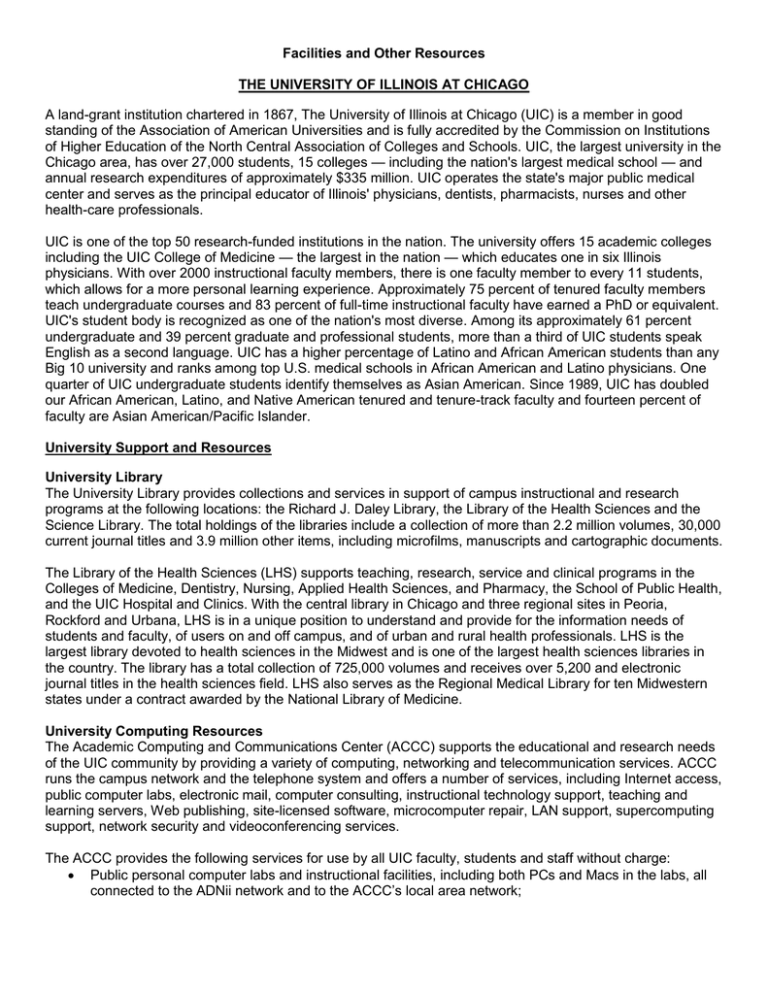
Facilities and Other Resources THE UNIVERSITY OF ILLINOIS AT CHICAGO A land-grant institution chartered in 1867, The University of Illinois at Chicago (UIC) is a member in good standing of the Association of American Universities and is fully accredited by the Commission on Institutions of Higher Education of the North Central Association of Colleges and Schools. UIC, the largest university in the Chicago area, has over 27,000 students, 15 colleges — including the nation's largest medical school — and annual research expenditures of approximately $335 million. UIC operates the state's major public medical center and serves as the principal educator of Illinois' physicians, dentists, pharmacists, nurses and other health-care professionals. UIC is one of the top 50 research-funded institutions in the nation. The university offers 15 academic colleges including the UIC College of Medicine — the largest in the nation — which educates one in six Illinois physicians. With over 2000 instructional faculty members, there is one faculty member to every 11 students, which allows for a more personal learning experience. Approximately 75 percent of tenured faculty members teach undergraduate courses and 83 percent of full-time instructional faculty have earned a PhD or equivalent. UIC's student body is recognized as one of the nation's most diverse. Among its approximately 61 percent undergraduate and 39 percent graduate and professional students, more than a third of UIC students speak English as a second language. UIC has a higher percentage of Latino and African American students than any Big 10 university and ranks among top U.S. medical schools in African American and Latino physicians. One quarter of UIC undergraduate students identify themselves as Asian American. Since 1989, UIC has doubled our African American, Latino, and Native American tenured and tenure-track faculty and fourteen percent of faculty are Asian American/Pacific Islander. University Support and Resources University Library The University Library provides collections and services in support of campus instructional and research programs at the following locations: the Richard J. Daley Library, the Library of the Health Sciences and the Science Library. The total holdings of the libraries include a collection of more than 2.2 million volumes, 30,000 current journal titles and 3.9 million other items, including microfilms, manuscripts and cartographic documents. The Library of the Health Sciences (LHS) supports teaching, research, service and clinical programs in the Colleges of Medicine, Dentistry, Nursing, Applied Health Sciences, and Pharmacy, the School of Public Health, and the UIC Hospital and Clinics. With the central library in Chicago and three regional sites in Peoria, Rockford and Urbana, LHS is in a unique position to understand and provide for the information needs of students and faculty, of users on and off campus, and of urban and rural health professionals. LHS is the largest library devoted to health sciences in the Midwest and is one of the largest health sciences libraries in the country. The library has a total collection of 725,000 volumes and receives over 5,200 and electronic journal titles in the health sciences field. LHS also serves as the Regional Medical Library for ten Midwestern states under a contract awarded by the National Library of Medicine. University Computing Resources The Academic Computing and Communications Center (ACCC) supports the educational and research needs of the UIC community by providing a variety of computing, networking and telecommunication services. ACCC runs the campus network and the telephone system and offers a number of services, including Internet access, public computer labs, electronic mail, computer consulting, instructional technology support, teaching and learning servers, Web publishing, site-licensed software, microcomputer repair, LAN support, supercomputing support, network security and videoconferencing services. The ACCC provides the following services for use by all UIC faculty, students and staff without charge: Public personal computer labs and instructional facilities, including both PCs and Macs in the labs, all connected to the ADNii network and to the ACCC’s local area network; Instructional support/consulting: free courses on computer topics and free general consulting on issues related to the ACCC systems, the ADNii network, microcomputing and electronic mail. In addition, instructional support is provided to faculty who wish to integrate computers and computing into their courses. The School of Public Health The University of Illinois at Chicago School of Public Health (SPH) was established in 1970 and is accredited by the Council on Education for Public Health. UIC SPH is the only fully accredited school of public health in the state of Illinois. UIC SPH has as its mission the enhancement of quality of life through improving the public’s health and serves as a critical link in the education of the nation’s public health work force. The UIC SPH is particularly recognized for its strong programs in prevention research (including violence prevention and drug prevention outreach programs), health promotion, maternal and child health, gerontology, environmental and occupational safety and health, infectious diseases, cancer, asthma, biostatistical methods (including random effects modeling, longitudinal data analysis and linear models), public health informatics, public health policy, and public health practice and leadership. School of Public Health Facilities Three buildings provide modern, well-furnished, well-equipped teaching, research, conference, interview and study facilities for faculty, students, staff and community groups and organizations. The Office of the Dean and the school’s administration, the Community Health Sciences Division, the Epidemiology and Biostatistics Division, and the Health Policy and Administration Division are housed in the School of Public Health building located at 1603 West Taylor Street. The 1603 West Taylor (School of Public Health and Psychiatric Institute, or SPHPI) building provides 127,000 square feet and offers an auditorium, a multi-purpose activity room for special events, a parenting room, interview rooms, the Paul Q. Peterson Study Center, the Alan W. Donaldson Student Lounge and a cafe. The Environmental and Occupational Health Sciences Division faculty, classrooms and laboratories are housed in the School of Public Health building at 2121 West Taylor Street (School of Public Health-West or SPHW) which includes approximately 80,000 square feet. The division has 10,500 square feet of laboratory space for teaching and research. Laboratory capabilities include biochemical and cellular analyses; gas and liquid chromatography and mass spectrometry; particle and aerosol analyses; particulate, chemical and noise measurement; weather and air pollution monitoring, and water quality and trace metal analysis. The division’s computer laboratory allows access to extensive university resources via the UIC mainframe. The Institute for Health Research and Policy, located at 1747 West Roosevelt Road, provides 36,500 square feet for research, teaching, conference and focus group facilities. SPH Computer Resources School of Public Health Computer Resources All faculty and staff in SPH are provided with desktop or laptop computers which are connected to the Internet but protected via firewalls and intrusion detection software. In addition, faculty have access to secure storage within the College through a firewalled local area networks. Once students have UIC identification cards and their unique computer accounts, they have access to the SPH computer labs, located in the two School of Public Health buildings, as well as to the Academic Computing and Communications Center computer labs across the campus. The auditorium and major conference rooms are equipped for teleconferencing. SPH Computer Resources & Data Security All computing facilities for faculty and staff in SPH are provided through an authenticated virtual local area network which requires authentication via the campus unified identity management system, which is based on Microsoft Active Directory. This infrastructure provides for integrated network administration and information security. Appropriate access is granted to individuals to access, stored, and modify data on systems administered by the School and the University. Each desktop and laptop has a set of standard software that provides users with effective productivity and security tools. Fileservers and data stores that faculty and staff use to store and share information are secured in a secure server room with backup and disaster recovery policies and procedures in place. Methods and Systems for Securing Data SPH practices for data collection, storage, transmission and sharing of High Risk data include: Data Collection: Capture of high-risk and secure data, via an electronic survey, must be done through either REDCap (Research Electronic Data Capture) or Qualtrics. Both are HIPAA-compliant web-based applications for building and managing online collections of sensitive and high-risk data. Data Storage: High-risk and sensitive data must be on either a University, SPH provided, or authorized cloud-based secured server. All approved cloud-based solutions must be HIPAA-compliant and must have an executed BAA with the University. If the data is to be used on a local computing device, the device must be encrypted with either the native facility of the applicable operating system (such as BitLocker on Windows or FileVault 2 on OSX) or with PGP Whole Disk Encryption. Data Transmission: All sensitive and high-risk data must be transmitted via an encrypted protocol such as https or SFTP. An intercampus secure e-mail solution is available through the PEAR system; however there is no available secure campus email solution for message outside of UIC. Data Sharing: the practice for sharing high-risk and sensitive data within SPH is to store data on a secured server either in the School or in the University’s central computing facilities. An SFTP server is available to share files with individuals outside of the UIC community. Divisions of the School of Public Health The School of Public Health is organized into four academic divisions and a number of specialized research, service and training centers and programs. Community Health Sciences Division (CHS) The Community Health Sciences Division focuses on public health practice aspects of community health as they relate to the interaction of individuals, families and community structures. The behavioral sciences form the theoretical basis for community applications to enhance health and well-being. CHS offers three tracks in which students can focus their studies: behavioral sciences and health promotion, gerontology, or maternal and child health (including MCH epidemiology), or students may develop an individualized program. Students may combine track courses with other CHS topic areas such as developmental disabilities, global health, public health practice, public health nutrition and women’s health studies. The following program is housed in the CHS Division: Maternal and Child Health Center for Excellence The goal of the Maternal and Child Health Center of Excellence is to provide graduate leadership education for individuals pursuing careers in maternal and child health. It is a comprehensive, competency-based program focusing on the health needs of women, children and families and on the services designed to meet these needs. The MCH Center of Excellence is one of twelve such programs funded at schools of public health in the United States through the federal Maternal and Child Health Bureau. Environmental and Occupational Health Sciences Division (EOHS) The Environmental and Occupational Health Sciences Division prepares students to protect the environment and improve the health of workers and the general public. EOHS students learn to anticipate, identify and assess environmental and workplace health hazards, recommend corrective measures, institute programs to reduce morbidity and mortality, and evaluate these efforts. A highly interdisciplinary area of study, EOHS students draw upon the fields of toxicology, epidemiology, engineering, industrial hygiene and other sciences to identify and control risks. Specialized study is offered in: air pollution, industrial hygiene, water quality and health, occupational medicine, environmental chemistry, occupational safety and hazardous substances management, toxicology, occupational and environmental epidemiology, and environmental and occupational health policy. The following programs, centers, and institutes are housed in EOHS: The Great Lakes Centers (GLC) The Great Lakes Center is a group of multi-institutional and multi-disciplinary service and outreach components. Participating institutions include: the School of Public Health; Colleges of Nursing and Agriculture; Institute for Labor and Industrial Relations; and the John Stroger Hospital (formerly Cook County Hospital). The groups’ core is located at the School of Public Health. GLC houses a World Health Organization Collaborating Centre in Occupational and Environmental Health with emphasis on the mining sectors and the training of primary healthcare workers. Eastern Europe is the focus of global programs are funded by the National Institutes of Health Fogarty International Center. Occupational and Environmental Health is a component that includes the Occupational Health Services Institute and provides clinical services, community consultations, and medical advisorships for companies. The institute’s occupational medicine physicians run the university employee Health Service, operate two Association of Occupational and Environmental Medicine Clinics, and serve as medical advisors for major corporations in the region. It has a large continuing education component for professionals, workers, and community members. It runs a hotline for the community related to occupational and environmental health concerns for workers, children, and communities. Children’s Environmental Health is a component that includes a regional center for pediatric environmental health with support from the Agency for Toxic Substances and Disease Registry, the U.S. Environmental Protection Agency, the American Academy of Pediatrics, and the Association of Occupational and Environmental Medicine Clinics. This center exists to evaluate, treat and prevent environmental illnesses in children, train pediatricians and other healthcare professionals in pediatric environmental health issues, expand knowledge of children’s environmental health problems through research and promote children’s environmental health in communities. The Illinois Occupational and Environmental Health and Safety Education and Research Center is one of sixteen centers funded by the National Institute for Occupational Safety and Health. The ERC includes graduate programs in occupational and environmental medicine, industrial hygiene, occupational health nursing, agricultural safety and hazardous materials, and offers continuing education to professionals in occupational safety and health, hazardous materials, and agricultural safety and health, and worker training programs. The ERC also supports research training in assessment of mixed exposures and respiratory disease and funds pilot research projects to foster career development in occupational safety and health research. Global Environmental and Occupational Health is a WHO Collaborating Centre, involved with supporting workforce development among primary care providers in the realm of occupational medicine; it also runs a workforce development course for managers responsible for occupational and environmental health and safety in multinational companies and governments. GLC houses a NIH Fogarty GEOHub for Ukraine and Eastern Europe. The center engages in training, research, consultation and capacity-building activities with partner institutes. GLC maintains the GeoLibrary, a repository for occupational health training curricula in five languages. Finally, GLC develops and evaluates continuing education curricula for international entities. Mining Health and Safety is an expanded focus for GLC. GLC houses a HRSA funded Black Lung Clinic program, which conducts outreach, primary care, patient and family education and counseling, patient care coordination, and pulmonary rehabilitation. It was recently awarded a HRSA Black Lung Center of Excellence grant. In addition, GLC is conducting research and surveillance of diseases associated with coal dust exposure, as well as education and outreach for miners and affected communities. Health in the Arts is comprised of medical specialists and hygiene and safety personnel who diagnose and treat arts-related disorders, educate artists and hobbyists on hazards in the arts, provide consultation on workplace safety and hazard control, and conduct research on the causes and prevention of arts-related disorders. Epidemiology and Biostatistics Division (EPI-BIO) The disciplines of Epidemiology and Biostatistics are housed within the same division. Epidemiology studies the distribution and determinants of disease and other health-related events in populations. Epidemiologic methods are used to establish links between risk factors and disease (e.g., diet and prostate cancer), clarify the distribution of disease locally, regionally, nationally, and internationally (e.g., global distribution of AIDS), elucidate the natural history of many diseases (e.g., cervical cancer), assess the effectiveness of public health interventions and evaluate health resource utilization. Biostatistics is the development and application of statistical methods to problems in biology, medicine, public health and other life sciences. Solutions are sought through management, analysis, and interpretation of data; study design and the acquisition of data analysis knowledge. The following programs are housed in the EPI-BIO Division: The Community Asthma Prevention Program The Community Asthma Prevention Program responds to a high rate of asthma hospitalization and mortality in low-income Chicago neighborhoods. A community-based peer educator program aims at decreasing risk factors for asthma. The goals of the project are to increase understanding of the dynamic process by which asthma develops in children, identify modifiable risk factors and demonstrate the effectiveness of intervention strategies that target the needs of underserved populations. Center for Biostatistical Development (CBD) The Center for Biostatistical Development provides a biostatistical research environment aimed at fostering and developing innovative methods to address health-related scientific problems. The CBD also provides education and training, via lectures and workshops, to increase the accessibility and use of the novel statistical methods. The overall goal of the CBD is to provide and disseminate biostatistical research that will address and advance questions in the health sciences. Health Policy and Administration Division (HPA) The Health Policy and Administration Division provides students with the conceptual and analytical tools needed to: analyze the implications of proposed policies; influence their formation; evaluate them once implemented; and manage private and/or public health care organizations so as to improve the health of the population. HPA students may develop concentrations in health services research, health care administration, health policy analysis and public health informatics. The following programs are housed in the HPA Division: Fogarty UIC AIDS International Training and Research Program (AITRP) Funded through the John E. Fogarty International Center, the international training arm of the National Institutes of Health, the AIDS International Training and Research Program is designed to build longterm scientific capacities that help to address the AIDS epidemics in China, Chile, Indonesia and Malawi. The AITRP is a collaborative effort of the UIC School of Public Health, the UIC College of Nursing, the Great Lakes Centers for AIDS Research at Northwestern University and key institutional participants in the four participating countries. The AITRP is designed to provide biomedical and behavioral science training in HIV/AIDS prevention at the MS, PhD and post-doctoral levels at UIC for students and practicing professionals from the four participating countries. The program also sponsors short-term “in-country” AIDS research training for U.S. minority scholars and helps to foster cooperative scientific relationships between the program’s collaborating countries, UIC and the Great Lakes Centers. Center for Employee Health Studies The Center for Employee Health Studies (CEHS) researches complex organizational policies and behavioral influences to improve the health of employees and their dependents, increase employee engagement, and maximize productivity. The Center collaborates with employers, payers, providers, foundations, public agencies and other key stakeholders to impact population health and cost. CEHS has identified four areas of focus for the center’s work. All programs, projects and activities of CEHS are in support of one or more of these areas, which include: Employee Decision Making and Demand Management, Workers' Compensation, Employee and Organizational Health and Productivity, and Employment-based Policy Research. Centers, Institutes and Programs of the School of Public Health The Center for the Advancement of Distance Education (CADE) The Center for the Advancement of Distance Education (CADE) partners or contracts with university, government and non-profit organizations to provide Web-based solutions to meet a variety of educational, training, research and administrative needs. These collaborations include the creation of interactive online training modules, the design and development of Web sites, simulations and games, multimedia production and Webcasting, course registration and learning management system construction, Web-based programming and database connectivity, and online data gathering and analysis. Cure Violence (formerly The Chicago Project for Violence Prevention) Cure Violence was founded in 1995 and launched under the names “The Chicago Project for Violence Prevention” and “CeaseFire.” With funding through the Robert Wood Johnson Foundation Local Funding Partnerships program, CeaseFire was designed to engage youth and mediate high-risk conflicts before they turn violent. Cure Violence stops the spread of violence in communities by using the methods and strategies associated with disease control – detecting and interrupting conflicts, identifying and treating the highest risk individuals and changing community norms. Ranked as one of the top 20 NGOs in the world by Global Geneva in 2015, the Cure Violence model is now being replicated in in more than 60 sites around the world. Cities have turned to the Cure Violence Health Model to prevent teen violence – from sectarian violence in Iraq, to community violence in Honduras, to prison violence in England. Cities across the US have recognized the added value of the Cure Violence Model and are implementing the program to augment efforts of law enforcement, social service and other agencies. In August, 2014, New York City announced an expanded citywide initiative to reduce gun violence, which essentially triples the Cure Violence program in New York City. This new $12.7 million initiative expands Cure Violence from 5 to 14 precincts which account for 51% of the shootings in NYC. Cure Violence had its genesis in the global health experience of Gary Slutkin, M.D., Professor of Epidemiology and International Health at UIC School of Public Health. As chief of interventions and prevention for the World Health Organization, Gary devoted years as a WHO leader and physician to curing infectious diseases from tuberculosis in San Francisco and Somalia to HIV in Uganda. Dr. Slutkin understands how disease spreads and the kinds of intervention necessary to stop it. He characterizes the clinical features of violence with the same medical terminology used to describe other contagious disease. Individuals are more likely to be susceptible if they live in an environment in which violence is a well-established norm – their exposure to violence increases the likelihood they will become violent themselves. The Community Outreach Intervention Projects (COIP) The Community Outreach Intervention Projects was founded in 1986 to address HIV/AIDS particularly among substance users. COIP operates from storefront sites in five areas of Chicago: Austin (west side), Humboldt Park (near northwest side), West Englewood (south side), South Chicago (southeast side), and Uptown (north side). COIP serves other neighborhoods in the city and inner-ring suburbs through its mobile units. COIP's interventions are known for their use of the Indigenous Leader Outreach Model, which employs former drug users to deliver services and assist in conducting research. COIP’s services include street outreach, diabetes and blood pressure screening, HCV screening and linkage to care, counseling and testing for HIV/AIDS, syphilis and other infectious diseases associated with substance use, case management for persons living with or at high risk for HIV infection, syringe exchange, drug abuse and risk reduction counseling, support groups, educational activities, substance use treatment, and projects that enhance linkages to care for HIV-positive men and women exiting jail. COIP also refers clients to other providers such as drug treatment programs. In collaboration with UIC’s HIV Community Clinic Network (HCCN) in the Division of Infectious Disease, all COIP’s storefront sites provide free medical, mental health, and pharmacy care for people living with HIV, with some sites having additional services such as social work and HIV and substance abuse support groups. In 2014, COIP provided direct services to 6,699 people. COIP also conducts research to better understand and prevent HIV/AIDS in Chicago communities. Recent studies have examined or evaluated 1) an intervention to prevent hepatitis C transmission among young people who inject drugs, 2) mental health problems and their relation to HIV risk behaviors among young people who inject drugs, 3) transitions into drug injection by young people who ‘snort’ heroin, 4) the impact of syringe exchange on preventing HIV infection, 5) early stage hepatitis C infection and treatment response, 6) an intervention that engages the parents of young injection drug users to help their children reduce the risk of HIV infection, 7) the sexual transmission of HIV in metropolitan Chicago among and between injection drug users, substance-using men who have sex with men, and the sex partners of both groups, 8) linkages among mental health, family functioning, peer and partner relationships, and HIV-related cognitions among teens in mental health care, 9) mother-daughter communication and relationships in relation to early sexual initiation and risky sexual behavior among African American girls seeking psychiatric care, 10) family-based and affectregulation interventions to reduce risky sexual behavior among mentally ill youth and teens in therapeutic day schools, 11) HIV prevention interventions for juvenile offenders, 12) a “Seek, Test, Treat & Retain” model for preventing HIV through improving the identification of HIV cases and adherence to HAART that begins at entrance to jail, continues through prison, and extends into the community after release from jail and prison, and 13) global HIV prevention efforts in South Africa, Rwanda, China, and Indonesia. A leader in HIV prevention among substance users, COIP staff has conducted trainings in over 30 states, Canada, Australia, and in countries in South America, Southeast Asia, and Europe. A manual documenting COIP’s intervention methods was commissioned and published by the National Institutes of Health. When the Congressional Black and Latino Caucuses developed an initiative in the late 1990s to deliver proven HIV prevention interventions to high-risk communities of color in the US, COIP’s Indigenous Leader Outreach Model was the approach chosen by 85% of the newly funded programs. COIP has been cited as a model program by the World Health Organization, the National Institutes of Health, the Secretary of Health and Human Services, a Carnegie Foundation commission, and the Chicago Department of Public Health. The Institute for Health Research and Policy (IHRP) Established by the Illinois Board of Higher Education in 1997 as a cross-campus initiative, the Institute for Health Research and Policy stimulates and supports a broad range of high-quality research to improve health practices and policies. In carrying out this research, the institute is committed to fostering the collaboration of researchers across disciplines, mentoring and training new investigators, addressing disparities in health, and working in partnership with community leaders and residents to improve health in their communities. The work of the institute spans social and behavioral health research, from basic science (including methods and theory development) and intervention development, to clinical and efficacy trials, research-to-practice and practice-to-policy translation, and dissemination. The institute’s research encompasses large-scale center grants and program project studies. The institute’s director is Robin J. Mermelstein, PhD, professor of psychology and clinical professor of community health sciences, who is an internationally known expert in health behavior research and translation of research findings into practice. UIC administers the institute through the dean of the School of Public Health, Paul Brandt-Rauf, PhD. The institute is an interdisciplinary intellectual community in which faculty from more than 30 departments and eight UIC colleges, including all six health sciences colleges, collaborate in research. The institute’s leadership includes social, behavioral and health scientists from multiple disciplines (economics, pharmacy, psychology, public health, medicine, sociology, and statistics). The institute’s researchers collaborate with and serve in leadership roles in other major research units on the campus, such as the UIC Center for Clinical and Translational Science and the UIC Cancer Center. The institute offers a unique opportunity for faculty collaboration in health and health policy research by providing a critical mass of investigators who can share expertise to create an environment rich in research resources. In addition to scientific expertise, the institute provides access to study populations and settings through the many projects active in communities, schools, hospitals, clinics, churches, and workplaces. Researchers affiliated with the institute partner with hundreds of entities to conduct research in real-world settings: community and non-profit organizations; faith-based and educational organizations; employers; health care facilities and providers; local, state, and federal government agencies; and university researchers and policy experts around the world. Opportunities for achieving synergies across lines of research are maximized as, for example, knowledge developed in etiological research can be used in designing interventions, and intervention study results can be used to inform effectiveness research and later dissemination and policy studies. Faculty members throughout UIC with interests in health or health policy research can participate in the institute’s work. Four interdisciplinary research centers recognized by the Illinois Board of Higher Education and one program comprise the institute: The Center for Health Behavior Research focuses on understanding the origins, progression, and change of health-compromising and health-promoting behaviors, and on the development and testing of behavioral interventions to reduce risk or promote health. This center is under the direction of the institute’s director, Robin J. Mermelstein, PhD. The Center for Pharmacoeconomic Research, based in the College of Pharmacy but affiliated with IHRP, promotes and facilitates advancement in understanding of the clinical, humanistic, and economic impact of pharmaceutical products, contemporary pharmacy services, and medication use policy with respect to the health and safety of patients, organizations, and society. Glen T. Schumock, PharmD, MBA, associate professor of pharmacy practice, directs this center. The Center for Research on Health and Aging addresses health issues affecting older persons, including prevention, health maintenance, and the cost, quality, and effectiveness of health care delivery systems, such as long-term care and managed care. Susan L. Hughes, DSW directs this center. The Health Policy Center conducts research on a range of health policy issues, with a focus on policies affecting health behavior, including drinking, smoking, illicit drug use, physical activity, diet, and related outcomes, and communicates information about health policies to policymakers and the public. Frank J. Chaloupka, PhD, distinguished professor of economics, directs this center. The Health Promotion Research Program focuses on interventions to reduce risk of cancer and cardiovascular disease through primary treatment and prevention studies of obesity and conducts randomized trials to understand the mechanisms that promote health lifestyles. Directing this center is Marian Fitzgibbon, PhD, professor of medicine and health policy and administration, director of the Section of Health Promotion Research in the UIC Department of Medicine, and the institute’s deputy director. Located in the Illinois Medical District, the institute occupies more than 50,000 square feet in one of the newest buildings on campus, offering researchers state-of-the-art conference and teaching facilities, two fully equipped focus group rooms with adjoining observation rooms, space for survey research and the benefit of proximity to other faculty and research teams working on complex health studies. News and information about IHRP research projects and findings are regularly posted on the website and in a regularly disseminated enewsletter. The institute’s Methodology Research Core (MRC), directed by Michael Berbaum, PhD, senior biostatistician, provides expertise to the institute’s investigators to address methodological or statistical issues that arise in the conduct of behavioral, social, public health, and biomedical research, including experimental design, measurement, power analysis, and statistical analysis. The core provides consultation in the development of data entry programs, quality control checks, development of codebooks and documentation, and the management of large data sets. This core ensures that rigorous methods for data entry, editing, and updating are available to all institute projects, and that data are clean and secure. MRC staff members are available to help projects adhere to security standards for their data, e.g., developing protocols to ensure that identifiers are secure and separate from other data and maintaining limited access to both identifier and data files. The core has expertise in data management across a variety of data collection modalities, from paper and pencil questionnaires and handheld computer assessments, to Web-based surveys and qualitative interviews, as well as substantial experience in managing large-scale longitudinal data sets. The core provides state-of-the art statistical support and guidance to projects with considerable expertise in the analysis of longitudinal multilevel data, latent variable techniques, and models for missing data. The MRC offers short courses, didactic education, and lectures to enhance understanding of methodological and statistical advances. The MRC also works on the development and application of new statistical approaches as they apply to the data and analytic challenges of projects housed at the institute. The institute provides complete grant support, including pre-award development, grant application production, and post-award administration. Dedicated, full-time professionals provide support in the areas of human resources, budget development and management, human subject protection compliance, communications/media relations, and information technology. Experienced project staff are available to advise on a variety of issues in conducting community or field-based intervention research in a wide range of settings. The institute’s financial team supports more than 60 active research projects and about 60 proposal submissions annually. They manage a diverse research portfolio that includes RO1s, specialized grants (RO3s, R21s), NIH training grants, federally funded large-scale research initiatives such as center grants and program projects, and several multimillion-dollar research studies funded by the Robert Wood Johnson Foundation. The institute supports collaborative agreements with faculty in universities across the United States and international contracts with universities on four continents. The institute’s human resources team manages appointments for more than 200 faculty and staff members each year, recruits new staff, and advises IHRP staff and affiliated faculty on campus employment policies and procedures, including those regarding international appointments and visa sponsorships. They work closely with the financial team to ensure employees’ appointments are maintained in compliance with university and funding agencies’ policies through multiple and frequent changes in funding. Investigators and staff have access to the latest communications technology, high-speed Internet, secure servers, and data storage space. The institute features a modern, comprehensive computing environment, including servers and desktop computers connected in a local area network. In addition to the familiar office software suites, this environment supports the newest versions of statistical, analytical, mathematical and data processing software, including SAS, SPSS, and GIS packages. The in-house informational technology staff provides on-site maintenance of all equipment and servers, carries out regular back-ups, and supports new computing initiatives, from mobile information management tools to large data-set storage and computing needs. The institute also benefits from the services of the university’s Academic Computing and Communications Center, which supports site licenses for major software and statistical packages, enables researchers to purchase GIS and other software at discounted rates, and offers access to the UIC mainframes and a Beowulf Cluster for high-performance programming and statistical analysis. With diverse campus affiliations, the institute ranks among the four most productive research units at UIC. Funding sources include the National Institutes of Health, the Centers for Disease Control and Prevention, and other governmental agencies, including state and local health departments, as well as national and local foundations, such as the Robert Wood Johnson Foundation, and corporations. The MidAmerica Center for Public Health Practice (MCPHP) The mission of the MidAmerica Center for Public Health Practice is to build individual and organizational capacity to improve health by: Working with partners to creatively address public health practice issues; Translating public health research into practical resources; and Providing professional development, planning, and evaluation services. The MCPHP has collaborated with local, regional, and national partners to improve population health through public health workforce development. MCPHP offers a continuum of consulting services and technical assistance for practice organizations. The Center links workforce development initiatives to the strategic needs of partner organizations, often related to state and national priorities and issues. MCPHP brings together a combination of practice expertise and support to provide customized solutions to address current challenges in public health practice as well as to sustain, and complete complicated initiatives. MCPHP also promotes academic-practice partnerships to improve the performance of the public health system. By linking research to real-world practice, its goal is to improve the quality of education for master’s and doctoral students, and to explore and identify best practices for public health organizations. MCPHP offers professional training and education services that address a broad range of topics and issues, in areas such as organizational and community capacity, management, leadership, and preparedness. The services are tailored to meet the needs of public health practitioners in both rural and urban areas in the Midwest. Training activities include face-to-face, online, and blended learning options. MCPHP is able to apply technology to develop distance and blended learning solutions to deliver online trainings in a variety of formats. MCPHP also has the experience and tools needed to plan and execute meetings and conferences for the public health workforce around a multitude of topics. MCPHP focuses on three main areas of service – Training, Technical Assistance/Planning (TA/Planning), and Evaluation. The following provides examples of projects that use/used these services: Training MCPHP houses the coordinating office for the six-state Region V Public Health Training Collaborative, which will develop regional training programs and work together on state-specific training. The Collaborative is an unprecedented partnership to establish and implement a unified strategic approach to improving the workforce development infrastructure of the entire region. Each of the HRSA-funded Public Health Training Centers (PHTCs) have unique expertise, resources, and partnerships that together form a strong foundation for public health workforce development and capacity building. The Collaborative will address a shared regional theme of capacity building for population health improvement. The Region V Collaborative includes Illinois, Indiana, Michigan, Minnesota, Ohio and Wisconsin. This is one of 10 regional projects funded by the Health Resources and Services Administration (HRSA). The Illinois Preparedness and Emergency Response Learning Center (IPERLC) is also part of MCPHP. This Center addresses the preparedness training needs of the public health workforce in the State of Illinois, to enhance their capacity and performance to prepare for and respond to man-made and natural disasters. IPERLC works closely with its partners to assess, develop, deliver, evaluate and recognize the attainment of continued competency-based training and education. This Center is one of 14 funded by the Centers for Disease Control and Prevention. TA/Planning We Choose Health was an Illinois Department of Public Health (IDPH) initiative created to encourage and support the implementation of community health programs that addressed: Healthy Eating and Active Living; Smoke-Free Living; Healthy and Safe Built Environments. We Choose Health awarded 21 grantees covering 60 counties and impacting almost 3 million people in Illinois. MCPHP provided technical assistance, planning and support services to develop, coordinate, and implement the program for IDPH. This included developing the process for soliciting and selecting the grantees, communicating with and providing guidance to the grantees through the process, gathering information on their progress and outcomes, and preparing a final report - a Best Practice Guide, which outlining the impactful programs that were implemented across the State. MCPHP is also assisting IDPH in the development of their State Health Improvement Plan (SHIP). This is a legislatively mandated document focusing on health priorities and strategies for improvement that the state of Illinois must produce every four years, in order to maintain its accreditation as a state public health agency. The SHIP is informed by an assessment of the state’s current health condition, called the State Health Assessment (SHA). MCPHP is coordinating and working with the SHIP Planning Council, which serves as the body that guides the interpretation of Illinois’ State Health Assessment and the development of the State Health Improvement Plan. Evaluation In support of the Illinois Chapter of the March of Dimes (MOD), MCPHP was asked to conduct a formal statewide evaluation of the Becoming a Mom/Comenzando Bien prenatal education program. Activities included training on and facilitating data collection with the grantee sites; maintaining the database; reporting process/outcome data; provide ongoing evaluation input and feedback to MOD project staff related to program recruitment, retention, process and outcome measures, as well as reports to the State Program Services Committee. MCPHP provided services to the Community Memorial Foundation (CMF) to assure a seamless and integrated evaluation of their Health and Human Services Agenda. This included assistance in selecting indicators for the Agenda and assessing capability and capacity for data collection; assessing available data for measurement, including factors associated with collective impact and theory of change; and proposing an Agenda measurement and evaluation framework. A proposed evaluation plan was prepared, that was both retrospective and prospective. It also provided an assessment and recommendations on the feasibility of conducting an impact evaluation that included a return on investment analysis of CMF’s past work. MCPHP employs public health professionals that are familiar with a broad network of training resources and content experts; training program development; web-based learning applications; and those who are skilled in instructional design, technology and evaluation. Together, they use their experience in training and modern learning technologies to develop blended learning and unique distance learning solutions to facilitate and improve training, communication, and collaboration among various groups of public health practitioners and public health partners.

